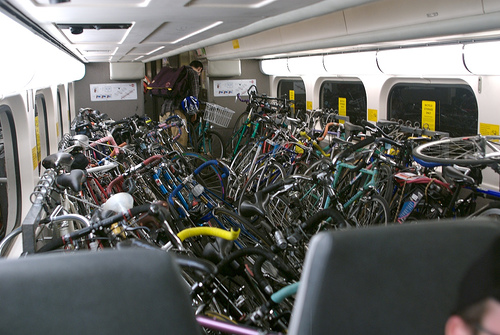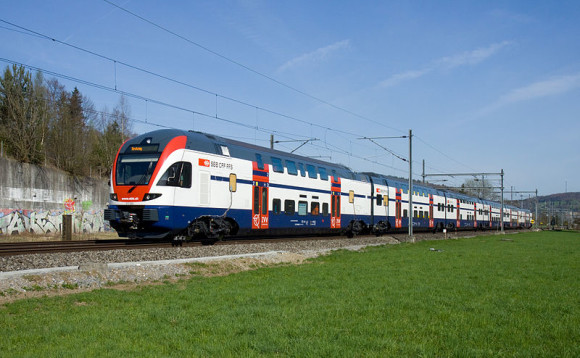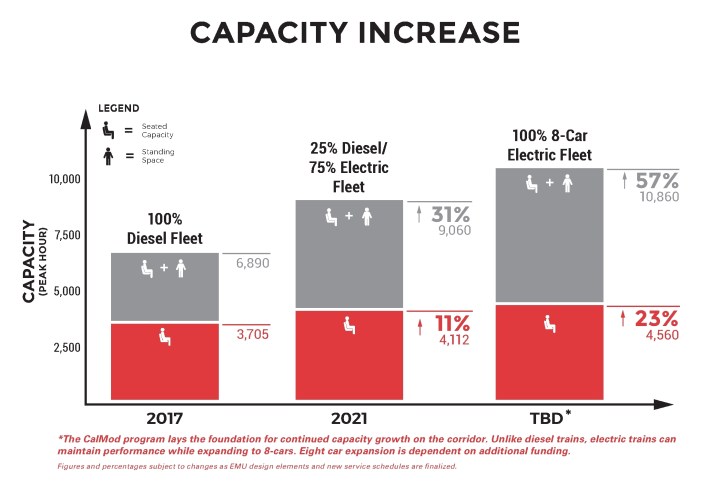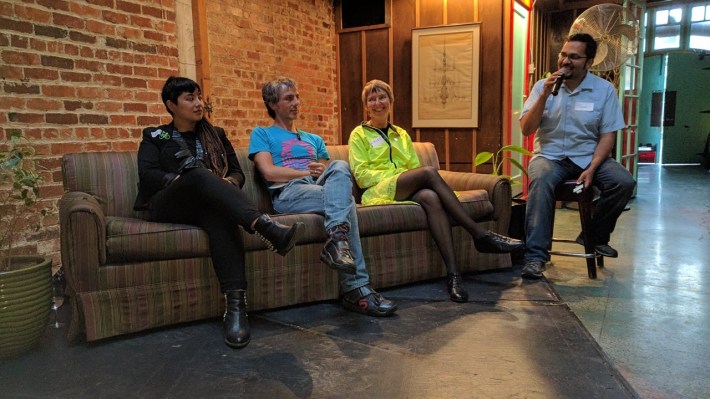Advocates Protest Rollback in Caltrain Bike Capacity
3:13 PM PDT on September 14, 2017

Despite promises, it looks as if Caltrain still plans to decrease space for bikes on its future electric trains.
The organization "BIKES ONBoard" is trying to put the brakes on Caltrain's plans to reduce the number of bike spaces on its trains.
From an open letter, written by Shirley Johnson, one of BIKES ONBoard's founders, to Caltrain:
Average bike capacity today is 77 bike spaces per train. For electrified trains, Caltrain staff is proposing only 72 bike spaces per train, 36 in each of two bike cars.
The letter also points out that Caltrain is claiming it will have higher bike carry numbers, in accordance with a directive from the Caltrain board: "Caltrain plans to run one more train per hour during peak commute once the line is electrified, claiming this is 12.5 percent (or 48) more bike spaces per peak hour in each direction. But the board approved an increase in bike capacity in train design, [emphasis added] with full knowledge that there will be one more train per peak hour."
For some background, in August Caltrain surveyed riders on the type of bike racks they preferred in the bike car--angled, stacked, hanging, or some kind of hybrid. At the time, Caltrain was claiming that, depending which system they went with, there would be between 68 and 72 bikes per train, or (claimed Caltrain) about an 8 to 12 percent increase over bike space for current trains.

Advocates and Streetsblog readers (thanks everyone...sorry again for missing this!) pointed out the sleight of hand there, since the current diesel fleet consists carry a max of 80 bikes per train. Streetsblog reached out to Caltrain again, and it turned out they were giving straight-forward bike counts per train when they said 68 and 72 bikes, but then using overall carry capacity numbers to claim an overall increase--in other words, because electrification will allow them to run more trains, they'll carry more bikes per hour, even if there are fewer bikes per train.
But Johnson points out the fallacy in this.
As rider demand increases along the Caltrain corridor, it's almost certain to outstrip Caltrains ability to keep up relative to the growth, even as it acquires electric trains. That will leave cyclists in the lurch. "An extra train per hour will be needed to accommodate increased ridership for both walk-ons and bikes. Walk-ons can still get on and stand if seats aren't available," she wrote to Streetsblog. "But bike riders will get bumped if there isn't bike space. Therefore it's critical to increase bike capacity in train design, which is precisely what the Caltrain Board unanimously approved in July 2015."

This looks to be the result of a tug-of-war between the Caltrain Board and staff, which still wants to maximize seats, instead of overall carry capacity that includes standees. "That's what they're always talking about at the board meeting--seats, seats, seats. In July 2015, when the Board approved a 'Request for Proposals' to go to vendors for the new trains, staff said they wanted a nine-to-one seat-to-bike-space ratio, which is the same as today," said Johnson in a phone interview with Streetsblog. She said the board pushed back and demanded more bike space built into the design of the trains themselves over the current fleet.
Johnson, as many are no doubt aware, has been fighting for bike space on Caltrain for a very long time. Nearly ten years ago, Johnson and BIKES ONBoard pointed out that Caltrain was actually denying itself around $1 million in annual revenue by bumping cyclists--and their fares--at a time when it had both extra room and a budget deficit. Yes, bike space is space that can't be used for a seat, but Johnson, with the help of the San Francisco Bicycle Coalition, was able to convince Caltrain over time that counting success by the number of seats available on its trains, instead of the number of paying customers it serves, is a foolish approach. Bumping potential riders who need a bike to get the last mile or so between a Caltrain station and home and office just reduces revenue--and puts more motorists on the freeways.

Johnson now finds herself fighting that same seats versus revenues fight again. "BART is doing it--they took out seats to raise standing space and Caltrain is going to have to do the same thing."
And while standing on a train during a commute is not ideal, it beats standing on the platform as your train pulls away without you because there's no more space.
Johnson, meanwhile, is asking people to:
Email Caltrain now, then come and speak up at the Caltrain Board meeting at 10 a.m., Thursday, October 5 at 1250 San Carlos Avenue in San Carlos to get Caltrain to hold to its promise of adding more bike space on its trains.
Stay in touch
Sign up for our free newsletter
More from Streetsblog San Francisco
Independent Safety Advocates Beef up the Wiggle
Signs and soft-hit posts installed by advocates make the Wiggle bike route calmer and safer for cyclists and pedestrians




